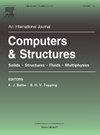求解时变有限元方程的显式-隐式时间积分新方法:Versa-δ法
IF 4.4
2区 工程技术
Q1 COMPUTER SCIENCE, INTERDISCIPLINARY APPLICATIONS
引用次数: 0
摘要
本文提出一种求解动态问题的显式-隐式时间积分方法。该方法通过调整特定的控制参数,可以方便地在显式和隐式形式之间切换。其余的控制参数进行了优化,以确保该方法在两种形式下都能提供完美的性能。该方法每个时间步长采用两个子步,可直接用作一阶和二阶方法,具有较高的抑制杂散响应的能力。随后对显式和隐式形式的一致性、稳定性、数值阻尼、精度顺序、振幅衰减和周期伸长进行了分析。此外,还将该方法与其他广泛使用的方法进行了具体比较,并分显式和隐式两个子步骤进行了比较。最后通过实例说明了该方法的实用性。本文章由计算机程序翻译,如有差异,请以英文原文为准。
A novel explicit-implicit time integration method for solving time-dependent finite element equation: The Versa-δ method
In this paper, we present a novel explicit–implicit time integration method for solving dynamic problems. The proposed method is designed to easily switch between explicit and implicit forms by adjusting certain control parameters. The remaining control parameters are optimized to ensure that the method would deliver a flawless performance in both forms. This method uses two sub-steps per time step and can directly be used as a first-order and a second-order method, with high capability to suppress spurious responses. The consistency, stability, numerical damping, order of accuracy, amplitude decay, and period elongation are later analyzed for both explicit and implicit forms. Additionally, the proposed method is compared specifically with other widely-used methods with two sub-steps, including both explicit and implicit approaches. Examples are also provided to demonstrate the method’s practicality.
求助全文
通过发布文献求助,成功后即可免费获取论文全文。
去求助
来源期刊

Computers & Structures
工程技术-工程:土木
CiteScore
8.80
自引率
6.40%
发文量
122
审稿时长
33 days
期刊介绍:
Computers & Structures publishes advances in the development and use of computational methods for the solution of problems in engineering and the sciences. The range of appropriate contributions is wide, and includes papers on establishing appropriate mathematical models and their numerical solution in all areas of mechanics. The journal also includes articles that present a substantial review of a field in the topics of the journal.
 求助内容:
求助内容: 应助结果提醒方式:
应助结果提醒方式:


